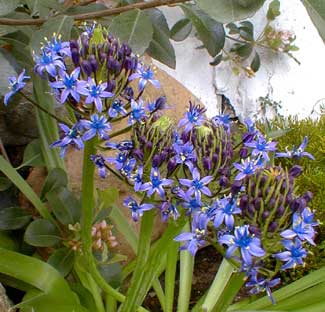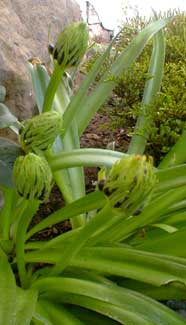
Giant Squill
also called:
Caribbean Lily,
Cuban Lily,
Hyacinth of Peru,
Peruvian Scilla,
Peruvian Lily,
Star of Peru,
Starred Jacinth
Right off the bat this has to be gotten out of the way, to note that despite the species name of Scilla peruviana & common names to match, this is neither a native of Peru nor of Cuba. It was first described by the pioneer taxonomist Linnaeus (1707-1778) as a native of southern Spain, named after the first ship to bring bulbs to England, The Peru. It was later additionally called Caribbean or Cuban Lily by right of having naturalized on Caribbean islands, especially Cuba, reinforcing the mistaken notion that it is a South American species.
It likes sandy well-drained soil, & needs a brief dry dormancy period in July, but for the rest of the year approaches being an evergreen. It can adapt to arid conditions with less water by lengthening its summer dormancy.
 They are best planted during their July/August dormancy period, but end up being marketed with other autumn bulbs to plant in October/November, when they will already be well sprouted, but will probably not suffer too much from such late planting.
They are best planted during their July/August dormancy period, but end up being marketed with other autumn bulbs to plant in October/November, when they will already be well sprouted, but will probably not suffer too much from such late planting.It likes to have the head of its bulb sticking above the soil. I planted ours in a little rockery, a single triple-bulb of Giant Squill which immediately began showing its grass in October. Its thick blades of foot-tall leaves provide a pleasing autumn & winter presence, but it does not bloom until the following May.
The second photo shows its buds at maximum size in April. The May Day photo at the top of the page shows some but not all of its buds fully opened. This is much the latest-blooming of several scillas in our gardens.
It is not invariably a reliable bloomer, but when a good one takes hold, it is a stunning addition to the garden, the large coryme of blue flowers lasting a good eight weeks. If it does skip a year blooming, it is probably keeping itself too busy producing more of its large bulbs, each one big as a fist, & it will eventually erupt more flowery than ever.
Whenever it is lifted to separate bulbs & replant, its blooming can be disrupted for a year or two, so it should be lifted as rarely as possible. It likes to be fertilized after blooming & until the leaves go summer-dormant, as this will help the big bulb recharge & lessen the possibility of skipping a year of blooms.
The plant is toxic. The leaves if bruised or cut smell of cat urine, so not a good choice for cut flowers.